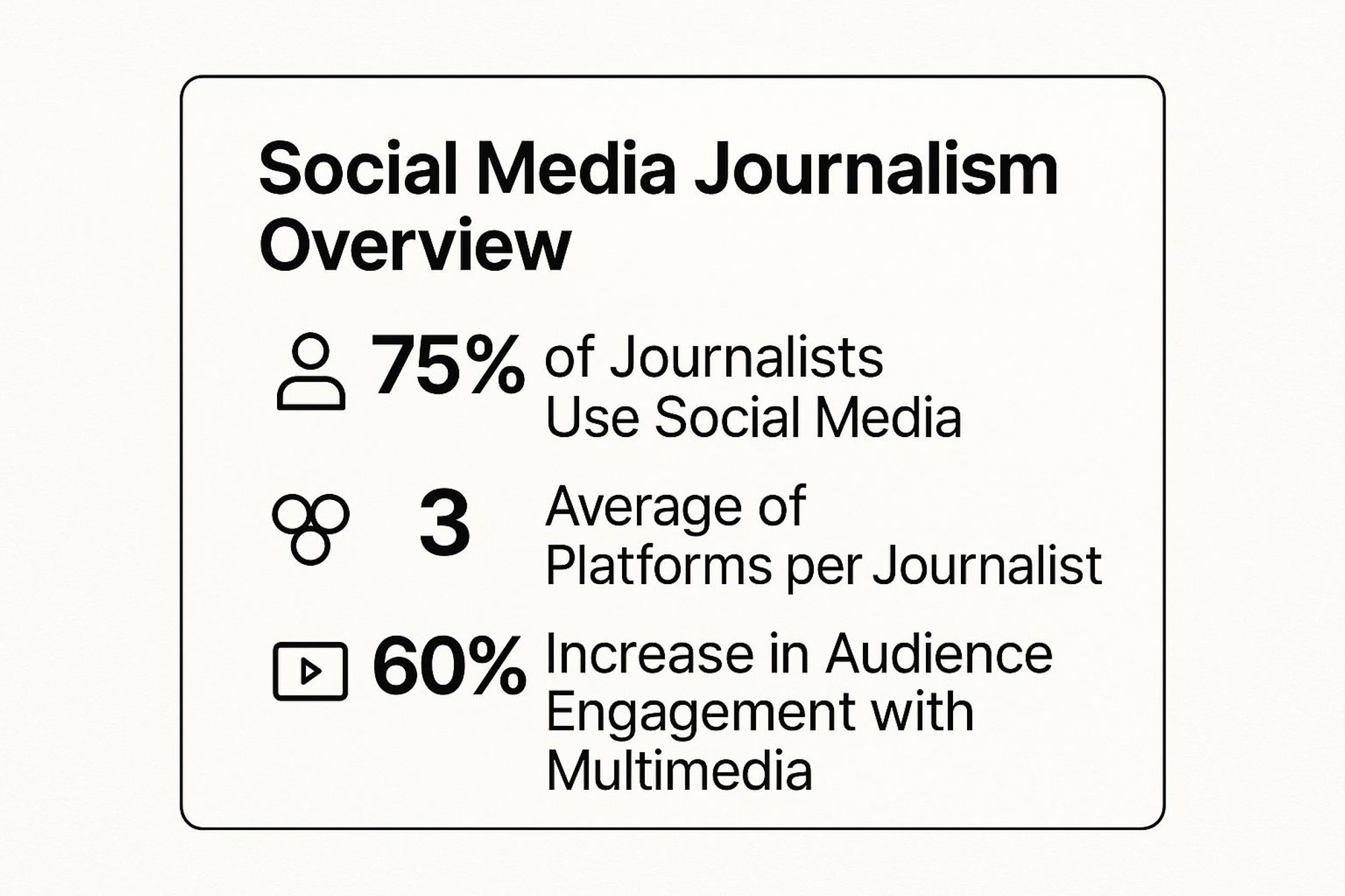Thursday, July 24, 2025
The Rise of the Social Media Journalist

A social media journalist is a new breed of storyteller, one who finds, verifies, and shares news on the very platforms where we all live and breathe. Forget thinking of them as just another broadcaster. They're a unique mix—part digital detective, part community manager, and part real-time fact-checker, all rolled into one. They operate at the dizzying speed of social media, shaping stories as they happen.
The New Face of News Reporting
The classic image of a reporter scribbling on a notepad, racing to meet a deadline for the evening paper? That's ancient history. Today's social media journalist is more like a digital town crier in a massive, sprawling global village. Their job goes far beyond just shouting headlines into the void.
It's about starting conversations, meticulously ensuring accuracy, and delivering news in the specific formats that work for each platform—whether that’s a snappy 60-second video on TikTok or a detailed, unfolding thread on X (formerly Twitter).
This role is absolutely vital in today's media world. This image really drives home just how deeply social media is embedded in the modern journalist's professional life.

The data doesn't lie. It's no longer enough for journalists to just use social media; they have to master multiple platforms to connect with an audience that's spread out all over the digital map.
The Digital News Frontier
The importance of the social media journalist has skyrocketed right alongside the platforms themselves. By 2025, we're looking at around 5.24 billion active social media users across the globe. That means these journalists are working where over 60% of the world's population hangs out.
And it's not just a quick glance. This digital population spends a staggering 14 billion hours every single day on social media, making it the go-to news source for a huge number of people. If you want to grasp the sheer scale of their playground, you can dig into these global social media trends.
The core responsibility of a social media journalist is not just to report the news, but to report it where the audience is, in a language they understand, and with the speed the platform demands. This requires a complete reimagining of the traditional news cycle.
How the Roles Differ
While the fundamental mission—to inform the public—hasn't changed, how it's done is worlds apart from traditional journalism. A social media journalist has to be a multimedia creator, a data analyst, and a community moderator, often all at the same time.
They don't just publish a story and walk away. They nurture it. That means jumping into the comments, debunking fake news in real-time, and constantly updating the story as new details pour in.
To see just how different these roles are, let's break it down. The table below highlights the key distinctions at a glance.
Social Media Journalist vs Traditional Journalist at a Glance
| Aspect | Traditional Journalist | Social Media Journalist |
|---|---|---|
| Speed & Cadence | Works on daily or weekly deadlines for print or broadcast. | Operates in a 24/7, real-time news cycle. |
| Audience Interaction | Primarily a one-way communication model (publication to reader). | Fosters two-way dialogue, sourcing stories and engaging directly. |
| Content Format | Focuses on long-form articles, structured TV/radio segments. | Creates platform-native content like videos, threads, stories, and infographics. |
| Verification Process | Has more time for in-depth verification before publication. | Must perform rapid, on-the-fly verification to combat misinformation. |
As you can see, the core of journalism is still there, but the tools, the tempo, and the way they connect with people have completely transformed. The social media journalist isn't just adapting to a new world; they're actively building it.
Mastering the Modern Journalist's Skill Set

To make it as a social media journalist today, you need a specific blend of old-school reporting chops and new-school digital savvy. It’s not just about firing off posts. It’s about cultivating a unique set of skills that let you navigate and lead conversations in a world that moves at the speed of a refresh button.
The single most important skill? Real-time verification.
Picture this: a major city event is underway, and suddenly, a dramatic image of widespread panic floods X (formerly Twitter). A traditional reporter might have a few hours to check its authenticity. A social media journalist has mere minutes. They have to be ready to jump on tools like reverse image search and metadata analysis to debunk a fake photo before it causes real-world harm.
This isn’t just a "nice-to-have" skill. It's an absolute necessity in an era where 54% of U.S. adults get at least some of their news directly from social media feeds.
Building Trust Through Engagement and Storytelling
Next up is genuine audience engagement. This isn’t about chasing likes or engineering viral hits. It’s about building a real, breathing community on platforms like Threads or inside a dedicated Facebook Group. A great social media journalist treats their audience like a key source, listening in on conversations to find story ideas that actually resonate with people.
For instance, they might start a thread asking for personal stories about rising housing costs or poll their followers on a controversial new city ordinance. This flips the script on traditional one-way broadcasting, turning reporting into a collaborative effort that builds trust and delivers far more relevant news. Even tasks like Twitter ghostwriting for growth teach invaluable lessons in capturing a unique voice and connecting with a niche audience.
A social media journalist’s power comes from being both a credible source and an active community member. They don't just broadcast to the crowd; they have a conversation with it, building a foundation of trust one interaction at a time.
Mastering Multimedia and Data
Finally, a social media journalist has to be a multimedia Swiss Army knife. Text alone just doesn’t cut it anymore. They need to be able to create punchy short-form videos, design clean infographics that tell a story at a glance, and write sharp, memorable copy tailored to each platform.
A single investigation could unfold as a detailed thread on X, an explainer video on YouTube, and a data-heavy graphic on Instagram—all working together.
This creative work goes hand-in-hand with data literacy. It's about knowing how to read the analytics and understand why certain content connects with people. This feedback loop allows the journalist to constantly fine-tune their approach and maximize their impact. If you want to make every word count, you have to improve writing ability effectively. This blend of creative storytelling and sharp analytical thinking is what defines the modern journalist's toolkit.
Inside a Social Media Journalist's Day
Forget the old-school newsroom with its slow, methodical pace. A day in the life of a social media journalist is more like a high-intensity sprint, a constant juggle between digging up stories and reacting to what’s happening right now. The day doesn’t kick off with a leisurely coffee and a newspaper; it starts with a deep dive straight into the digital world.
Mornings are all about social listening. And no, that's not just mindlessly scrolling through your feed. It’s a focused mission, using specialized tools to track keywords, monitor rising hashtags, and get a feel for what communities are buzzing about. The real goal is to spot the spark before it becomes a wildfire—maybe it's a small neighborhood concern, a video that’s starting to go viral, or a sudden spike in conversation around a particular topic. This is where truly original stories are born, straight from the public’s pulse.
From Discovery to Delivery
Once an interesting story starts to bubble up, the pace shifts into high gear. The afternoon becomes a whirlwind of rapid-fire content creation. This means verifying sources on the fly, writing sharp copy that’s tailored for each platform, and quickly putting together multimedia elements. A single story might need a detailed thread for X, a punchy explainer video for Instagram Reels, and a live Q&A session on Facebook to really land with the audience.
This is where having a solid plan—and the right tools—is non-negotiable. A journalist might use a scheduler to orchestrate how all these different pieces of content go live, making sure the story unfolds in a way that makes sense and gets the most eyeballs. Timing isn't just a suggestion; it's a core part of the strategy.
The real tightrope walk for a social media journalist is balancing speed with accuracy. You're often the first responder to breaking news, but you also have to be a meticulous fact-checker, sometimes with only minutes to tell fact from fiction before hitting “publish.”
Engaging and Measuring Impact
The day doesn't end just because a post is live. The evening often transitions into community engagement and analysis. This is an active role—jumping into comment sections, answering questions from the audience, and clarifying details as they come up. It's about nurturing the story long after it's been published. To build a community that trusts you, it's essential to understand how to boost social media engagement through real, authentic interaction.
At the same time, the journalist is glued to their analytics dashboard. They’re tracking real-time metrics—shares, comments, click-through rates, and overall sentiment—to see how the story is actually landing. This data isn’t just for a stuffy report; it’s what fuels the strategy for tomorrow. It creates a powerful feedback loop that keeps the entire news-gathering operation sharp and responsive.
The Ethical Tightrope of Digital News

Being a social media journalist means walking a digital tightrope, every single day. The job demands an almost impossible balance between the relentless need for speed and an unwavering commitment to the truth. This constant tension is what defines modern news.
Think of it like being two professionals at once. You have to be the 'first responder' to breaking news, ready to act in an instant. But you also have to be the 'forensic investigator,' meticulously checking every single detail before you push it out to a massive, and often very reactive, audience.
The pressure is immense. A story can go viral and reach millions in minutes, but that same speed can morph a tiny error into a full-blown misinformation crisis. The ethical stakes have never been higher.
The Double-Edged Sword of Real-Time Feedback
One of the most powerful parts of this job is having a direct line to your audience. Real-time feedback, comments, and shares give you incredible insight into what people truly care about. Sometimes, it can even help you uncover new angles to a story you're covering. It’s a living, breathing conversation.
But this open channel is a double-edged sword. It's also a direct pipeline for coordinated misinformation campaigns and targeted harassment aimed right at reporters. A journalist can find themselves caught in a vicious storm just for doing their job, which makes resilience a non-negotiable skill.
The constant stream of audience interaction is both the greatest asset and the biggest weakness for a social media journalist. It offers a connection like never before, but it also exposes them to direct attacks on their credibility and character.
Navigating Economic and Platform Pressures
Beyond the audience, major ethical challenges come from the social media platforms themselves. News organizations are increasingly dependent on social media advertising—a market that blew past $247.3 billion in 2024. With 97.3% of connected adults using social media every month, these networks are where most people get their news, making journalistic independence absolutely critical.
This financial reality forces journalists to grapple with algorithmic biases and platform policies that can bury or boost stories for reasons that have nothing to do with their newsworthiness. To maintain integrity while facing potential backlash, it's vital to have a solid grasp of social media crisis management strategies.
On top of all that, journalists have to balance their reporting duties with the need to prove their value using platform-specific metrics. While these numbers are important for strategy, an obsession with engagement can create a powerful temptation to sensationalize stories for clicks and shares. You can learn more about these key performance indicators in our guide to social media engagement metrics. In this complicated environment, a strong ethical compass isn't just nice to have—it's essential for survival.
Your Essential Toolkit for Modern Reporting
To make it as a social media journalist today, sharp instincts aren't enough. You need a powerful tech stack. The right tools don't just save you time—they unlock entirely new ways to find, verify, and deliver stories with real precision and impact.
Think of it as building your digital reporting workbench.
At the very heart of this setup is a solid social media management platform. Tools like Sprout Social or Schedul are your mission control. They let you schedule posts across different networks, figure out what content actually connects with your audience, and keep an eye on conversations as they happen. They turn a chaotic, endless feed into a structured dashboard where you can report strategically. You can see how the top platforms stack up in our comparison of social media management tools.
Creating and Verifying at High Speed
Next up, you need tools for lightning-fast content creation. We live in a visual world, so being able to quickly whip up a compelling graphic, video clip, or infographic is non-negotiable. Platforms like Canva or Adobe Express give journalists the power to design professional-looking assets without needing a degree in graphic design. It's about turning raw data into shareable stories in minutes, not hours.
But speed without accuracy is just a fast track to losing credibility. That’s why verification tools are absolutely essential.
- Reverse Image Search: A quick check using tools from Google or TinEye can help you trace an image back to its source. It’s the first step to seeing if it’s been stolen or doctored.
- InVID-WeVerify: This browser extension is a beast for debunking fake videos. It breaks them down into keyframes, letting you dig deeper and spot manipulations.
These tools are your digital magnifying glass. They're what protect your most valuable asset: your trustworthiness.
Using AI Responsibly
Finally, let’s talk about generative AI. It’s officially part of the toolkit, but it comes with a big "handle with care" sticker. It can be a fantastic assistant for brainstorming a few headline ideas or summarizing a dense, 50-page report to find the key takeaways. For a social media journalist juggling multiple stories, this can be a massive time-saver.
The economic engine behind social media journalism is huge. With ad spending on social platforms expected to climb to around $276.7 billion in 2025, the news content shared there plays a major commercial role. That puts pressure on journalists to be incredibly efficient, which helps explain why 90% of businesses using generative AI report productivity gains. You can dive deeper into these social media economic trends and insights on SproutSocial.com.
Platforms like Schedul are already integrating these AI functions, bringing your entire content workflow under one roof.
This kind of dashboard view shows you exactly how scheduling, analytics, and content creation can all live in one place. Having a unified system like this is the secret to staying organized, effective, and ahead of the curve.
Building Your Career in Digital News

So, you're ready to take your digital reporting skills and make a real go of it as a full-time pro? A career as a social media journalist is an incredible path to forge, and the doors are open wider than ever before. You don't have to shoot for the legacy media giants right out of the gate, either. Many of the most successful careers I've seen started at the local level.
Jumping onto a local newsroom's digital team is a brilliant first step. It’s where you build your core skills, get a real feel for community issues, and see the tangible impact of your work. From there, you can level up to a regional or national broadcaster, where the scale and resources are on a whole different level.
Of course, there's always the freelance route, which gives you complete independence. As a freelance expert, you get to build your personal brand from the ground up, chase the niche stories you’re actually passionate about, and partner with all kinds of clients. This path definitely requires a strong business mindset, but the flexibility is second to none.
Crafting Your Digital Portfolio
No matter which path you take, a killer portfolio is your single most important asset. Forget the dusty old resume; your social media profiles are your living, breathing credentials. Your portfolio needs to be a dynamic showcase of your reporting chops, verification skills, and ability to engage.
Your presence on platforms like X and LinkedIn is especially critical. Think of LinkedIn as your professional hub—it's where you'll connect with editors and newsroom leaders. It should be polished, highlighting your achievements, linking to your best work, and featuring recommendations from colleagues who can vouch for you.
X, on the other hand, is your real-time reporting arena. Use it to:
- Live-thread events to show you can report accurately and cleanly under pressure.
- Share multimedia content like short videos or infographics that you've created yourself.
- Engage with your audience and other journalists, proving you're an active and valuable member of the community.
Your portfolio's job is to prove you can do more than just report a story. It needs to show you can build and sustain an audience around it. This is a crucial skill that editors are actively looking for.
Networking and Professional Growth
Building connections is just as vital as building your portfolio. Get active in online journalism communities, join professional organizations, and don't be shy about reaching out to editors or reporters you admire. A solid network is often your ticket to job opportunities, collaborations, and priceless mentorship. For anyone starting out, learning how to build an online community around your reporting is a skill that will absolutely set you apart.
This field is all about constant change. Staying ahead of the curve means committing to being a lifelong learner. You have to keep up with new platforms, play around with emerging content formats, and constantly refine your ethical compass. That dedication to growth is what will ensure your long-term success and relevance as a social media journalist.
Got Questions? We’ve Got Answers.
If you're thinking about diving into the world of social media journalism, you've probably got a few questions buzzing around. It's a unique field, after all. Let's clear up some of the most common ones.
Do I Need a Specific Degree?
Not necessarily. While a classic journalism or communications degree gives you a fantastic head start, it’s far from the only path to success. I’ve seen incredible social journalists come from all sorts of backgrounds.
What really moves the needle is a killer portfolio that proves you can do the job. You need to show you can:
- Write sharp, compelling copy that feels native to social media.
- Edit video and create multimedia content that stops the scroll.
- Grasp the fundamentals of journalistic ethics inside and out.
- Actually build and engage a community on a social platform.
Think of it this way: your degree is the theory, but your portfolio is the proof. Certifications in things like digital analytics or specific video tools can also make your resume stand out.
Wait, Isn't This Just a Social Media Manager?
Ah, the million-dollar question. It's a common point of confusion, but the two roles couldn't be more different at their core. A social media manager works for a brand. Their goal is to market a product or service, drive sales, and build brand loyalty. Their success is tied to commercial outcomes.
A social media journalist, on the other hand, works for the public.
Their loyalty isn't to a product, but to the truth. The entire job revolves around reporting news accurately, verifying every claim, and holding fast to the ethical standards of journalism. They use the same platforms, but their mission is one of public service, not sales.
What Kind of Salary Can I Expect?
Like most media jobs, salaries for social media journalists can be all over the map. It really depends on your experience level, where you're located, and the size of the newsroom.
For someone just starting out, maybe at a smaller local outlet, you might see a salary in the $45,000 to $60,000 range. But as you build your skills and portfolio, you can climb the ladder to major national or global news organizations. Experienced journalists in senior or specialized digital roles often pull in well over $85,000, with the top talent in the field easily clearing six figures.
Ready to manage your reporting workflow like a pro? Schedul gives you the tools to schedule posts, analyze performance, and build your community all in one place. Start streamlining your social media strategy today with Schedul.
No credit card required!
